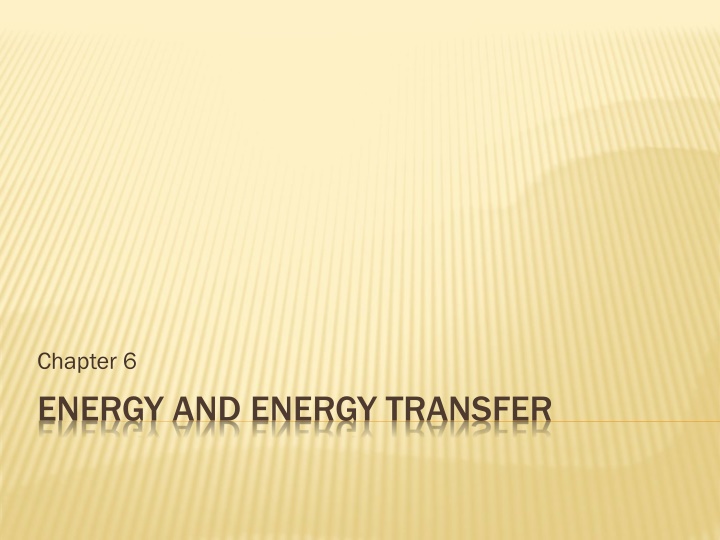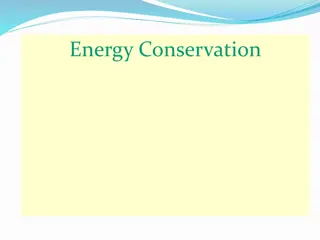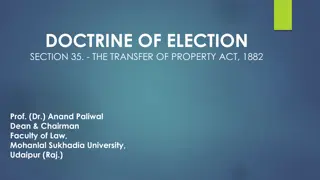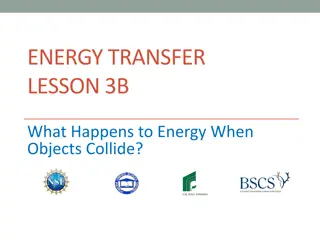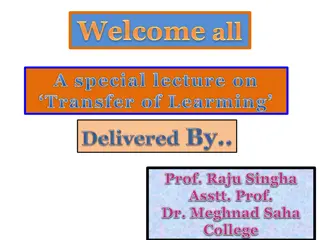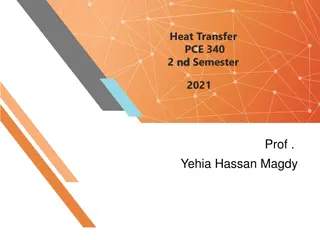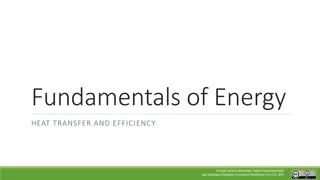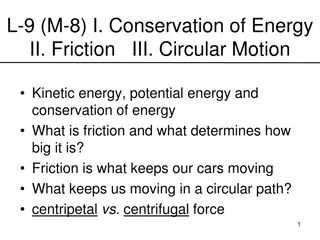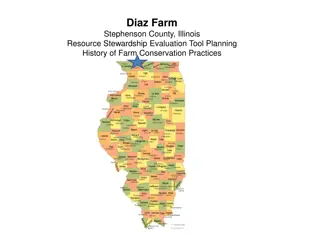Energy Conservation and Transfer
In this chapter, explore the concept of energy conservation and transfer. Understand how energy cannot be created or destroyed, only changed in form or transferred. Learn about different forms of energy such as kinetic, potential, and heat. Dive into mathematical concepts like vector dot product and work done by constant force. Discover the significance of the sign of work and practical examples of calculating work done by various forces.
Download Presentation

Please find below an Image/Link to download the presentation.
The content on the website is provided AS IS for your information and personal use only. It may not be sold, licensed, or shared on other websites without obtaining consent from the author.If you encounter any issues during the download, it is possible that the publisher has removed the file from their server.
You are allowed to download the files provided on this website for personal or commercial use, subject to the condition that they are used lawfully. All files are the property of their respective owners.
The content on the website is provided AS IS for your information and personal use only. It may not be sold, licensed, or shared on other websites without obtaining consent from the author.
E N D
Presentation Transcript
Chapter 6 ENERGY AND ENERGY TRANSFER
ENERGY IS CONSERVED Energy is conserved meaning it can not be created nor destroyed Can change form Can be transferred Total energy does not change with time.
ENERGY Forms Kinetic Energy Potential Energy Heat Unit: J (Joules) 1J = 1Nm = 1kg m2/ s2
MATH: VECTOR DOT PRODUCT u q v cosq > 0 when 0 <q < 90 cosq = 0 when q = 90 cosq < 0 when 90 <q <180
DOT PRODUCT EXAMPLE (a) Find the dot product of (b) What is the magnitude of (c) What is the angle between (a) v =(2)(-1)+(-3)(-1.2)=1.6 (b) (c) v = v cosq u v u q = cos-1(0.28) = 73.49 u =2 i - 3 j and u and v ? u and v =- i -1.2 j v u u = 22+ 32= 3.61, u v = 12+1.22=1.56 u 1.6 cosq = v = (3.61)(1.56)= 0.28
DOT PRODUCT EXAMPLE F 1= 2, F 2= 3, find F 1 Given F 2. F 1 Note that q =150 - 35 =115 , it is the angle between the two vectors. F 2= F 2cosq = (2)(3)cos(150 - 35 ) = -2.54 F 1
WORK BY CONSTANT FORCE W = F s = Fscosq where F = F ,s = s Unit: J WF > 0 WF = 0 Work means energy transfer. WF < 0 s WF > 0 Some book use the notation Dr instead of s. F
THE SIGN OF WORK The angle between the force and the displacement determines the sign of W.
FIND THE WORK DONE BY EACH FORCE WA= FAscos0 = FAs =15J WB= FBscos20 = 23.49J FC= 7N FD= 2N WC= FCscos(180 )= -FCs= -35J WD= FDscos(180 - 20 ) = FDscos(160 )= -9.40J Wtotal=WA+WB+WC+WD= -5.91J FB= 5N s = 5m FA= 3N
WORK BY CONSTANT FORCE You pull a chest (of weight 30N) 5m across the floor at a constant speed by applying a force of 50N at an angle of 30 . How much work have you done? Wyou = Fyou s cos =(50N)(5m)cos30 = 216.5 J Fyou = 50 N 30
WHERE DID THE ENERGY GO? You pull a 30 N chest 5m across the floor at a constant speed, by applying a force of 50 N at an angle of 30 . How much work did gravity do? How much work did normal force do? Fyou = 50 N How much work did friction do? 30
WHAT IS THE FRICTION? Fyou = 50 N f 30 a = 0
SUMMARY Wyou +216.5J WG 0J WN 0J Wf -216.5J Wtotal 0J
WHERE DID THE ENERGY GO? You spent 216.5J of energy pulling. Gravity and normal force absorbed none of the energy. Friction absorbed all 216.5J of energy. Negative work done means it absorbs instead of supplying energy.
POSITIVE AND NEGATIVE WORK If W>0, it means the force gives energy to the object. If W<0, it means the force absorbs energy from the object.
WHO DOES THE WORK? Make sure when you calculate the work done W, you know which force you are dealing with. In general, different force gives different work. Like in the previous example: Wyou Wgravity Wnormal Wfriction
NORMAL FORCE You are towing a car up a hill with constant velocity. The work done on the car by the normal force is: 1. positive 2. negative 3. zero FN V T mg
GRAVITY You are towing a car up a hill with constant velocity. The work done on the car by the gravitational force is: 1. positive 2. negative 3. zero FN V T mg
GRAVITY You are towing a car up a hill with constant velocity. The work done on the car by the gravitational force is: Given: T =10N,m = 7kg,q = 20 ,s = 5m s FN V T q a =q +90 =110 mg mg Wgravity= Fscos(angle) = (mg)(s)cos(110 ) = -117.3J
TENSION You are towing a car up a hill with constant velocity. The work done on the car by the tension force is: 1. positive 2. negative 3. zero FN V T mg
KE =1 KINETIC ENERGY 2mv2 If I did 100J of work to push an object of 2kg on a frictionless surface, what KE does it have in the end? Assume the object was initially at rest. KE =100J What is the final velocity? KE =1 2(KE) m 2(100J) 2kg 2mv2 v = = =10m / s
WORK KINETIC ENERGY THEOREM Wtotal= DKE = KEf- KEi All this says is that the total work we do on an object goes into its KE. Note that this is total work, not just the work of one of the forces. To calculate Wtotal, you need to find the work of all the forces and add them up.
EXAMPLE Alice and Bob are both pushing a box. Alice does 200J of work, Bob does -150J. What is the change in the KE of the box? WA= 200J WB= -150J Wtotal=WA+WB= 50J This energy goes into KE of the box: DKE = 50J In other words, it gains 50J of KE.
WORK BY CONSTANT FORCE You pull a 30 N chest 5 meters across the floor at a constant speed by applying a force of 50 N at an angle of 30 degrees. What is the total work done? Wtotal= DKE = 0J (constant velocity only) 50 N 30
TOTAL WORK You are towing a car up a hill with constant velocity. The total work done on the car by all forces is: 1. positive 2. negative 3. zero FN V T mg
WORK AND POWER Power = Rate of work P =dW dt Unit :W(Watts) 1W =1J /s Don't confuse this with work W! A 100W (=100J/s) light bulb consumes 100J of energy per second.
POWER OF A CONSTANT FORCE W = F s = Fscosq For constant force: P =dW dt but ds dt= v =d dt(Fscosq) = Fcosq(ds dt) P = Fvcosq = F v
WORK & POWER Engine of a jet develops a thrust of 15,000 N when plane is flying at 300 m/s. What is the power of the engine ?
POWER FOR CIRCULAR MOTION I swing a sling shot over my head. The tension in the rope keeps the shot moving in a circle. How much power must be provided by me, through the rope tension, to keep the shot in circular motion ? Rope Length = 1m Shot Mass = 1 kg Angular frequency = 2 rad/s v A) 16 J/s B) 8 J/s C) 4 J/s D) 0J/s
POWER FOR CIRCULAR MOTION Note that the string expends no power, i.e. does no work. Makes sense ? By the work kinetic energy theorem, work done equals change in kinetic energy. KE = 1/2 mv2, thus since v does not change, neither does KE. A force perpendicular to the direction of motion does not change speed, v, and does no work.
HORSE POWER AND WATTS Both measures power 1hp = 746W
KILOWATT-HOUR AND JOULES Both measure energy 1kWhis the amount of energy dissipated by a 1000 Watts light bulb in one hour. Therefore: 1kWh = (1000J/s) (3600s)=3.6 106 J
